Text created by ChatGPT and other Large Language Models is spreading rapidly across the Internet. It's well-written, artificial, frequently inaccurate. If you find a mistake on Spaceweather.com, rest assured it was made by a real human being. This is an AI Free Zone! | | |
FARSIDE SUNSPOT: There's a sunspot on the farside of the sun so large, it is affecting the way the whole sun vibrates. Helioseismic maps reveal the active region about 10 days away from turning toward Earth. This could herald a period of geoeffective solar activity in June. Solar flare alerts: SMS Text
ELLERMAN BOMBS: At the beginning of the week, sunspot AR3315 didn't exist. Now it is the biggest and most dangerous sunspot on the solar disk. Maximilian Teodorescu photographed the fast-growing active region yesterday and found it crackling with bomb-blasts:
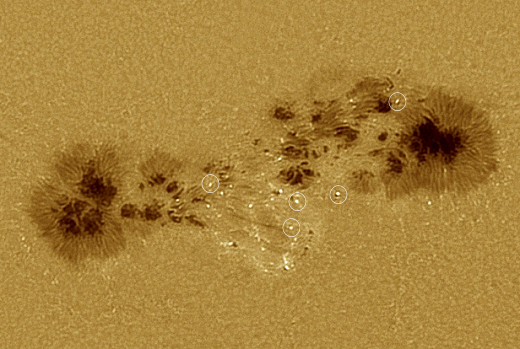
These are Ellerman bombs--magnetic explosions about one-millionth as powerful as true solar flares. A handful are circled above for reference. They are named after physicist Ferdinand Ellerman who studied the tiny blasts in the early 20th century. Of course, "tiny" is relative. A single Ellerman bomb releases about 1026 ergs of energy--equal to about 100,000 World War II atomic bombs.
Explosions like these are a sign of magnetic complexity in a sunspot. Opposite polarities bump together, reconnect, and--boom. A full-fledged flare may not be far behind. Solar flare alerts: SMS Text
more images: from Oleksandr A. Veles of Kyiv, Ukraine; from Apollo Lasky of Naperville, IL
Realtime Space Weather Photo Gallery
Free: Spaceweather.com Newsletter
A SUPERNOVA IN LONDON: A week after it exploded in a spiral arm of the Pinwheel Galaxy (M101), new supernova SN 2023ixf has finally peaked in brightness at magnitude +11. Turns out, that's bright enough to see from downtown London. "The supernova was easily visible in my telescope despite the bright lights of the city," reports Terence Murtagh.
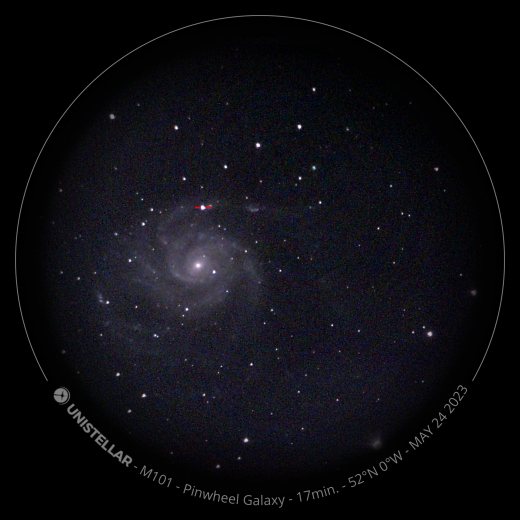
"I had great views of the supernova through my EVscope Equinox 2," he says.
SN 2023ixf is a Type II supernova caused by the core collapse of a massive star. A shock wave escaped the dying star on May 19th (Earth time), creating a 15th magnitude fireball first noticed by Koichi Itagaki of Yamagata, Japan.
The expanding fireball has since brightened 40-fold to magnitude +11. That's too dim to see with the unaided eye, but, as Murtagh's photo shows, it is an easy target for backyard telescopes even in urban areas. Take a look!
Realtime Space Weather Photo Gallery
Free: Spaceweather.com Newsletter
FOR FATHER'S DAY--THE MR. SPOCK COFFEE CUP: Father's Day is coming. You can now give dad the gift of coffee in a Mr. Spock Cup. It has pointy ears, holds 20 oz. of brew, and comes from the edge of space. The students of Earth to Sky Calculus flew this cup to the stratosphere onboard a cosmic ray research balloon:
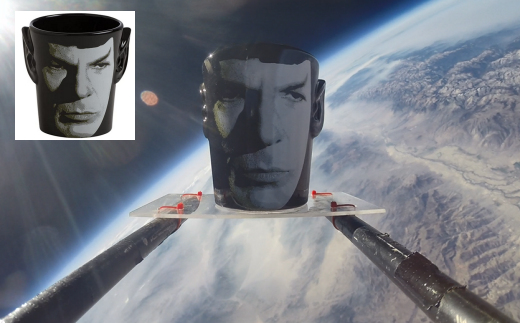
You can have it for $99.95. The students are selling Spock cups to support their cosmic ray ballooning program. Each one comes with greeting card showing the heavy-duty ceramic cup in flight and telling the story of its journey to the stratosphere and back again.
Far Out Gifts: Earth to Sky Store
All sales support hands-on STEM education
Realtime Aurora Photo Gallery
Free: Spaceweather.com Newsletter
Every night, a network of
NASA all-sky cameras scans the skies above the United States for meteoritic fireballs. Automated software maintained by NASA's Meteoroid Environment Office calculates their orbits, velocity, penetration depth in Earth's atmosphere and many other characteristics. Daily results are presented here on Spaceweather.com.
On May 26, 2023, the network reported 6 fireballs.
(6 sporadics)
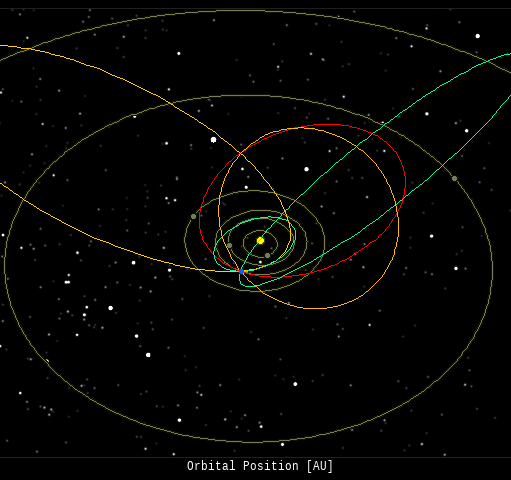
In this diagram of the inner solar system, all of the fireball orbits intersect at a single point--Earth. The orbits are color-coded by velocity, from slow (red) to fast (blue). [Larger image] [movies]
Potentially Hazardous Asteroids (
PHAs) are space rocks larger than approximately 100m that can come closer to Earth than 0.05 AU. None of the known PHAs is on a collision course with our planet, although astronomers are finding
new ones all the time.
On May 27, 2023 there were 2335 potentially hazardous asteroids.
 |
Recent & Upcoming Earth-asteroid encounters: | Asteroid | Date(UT) | Miss Distance | Velocity (km/s) | Diameter (m) |
| 2021 JK7 | 2023-May-22 | 16.7 LD | 22.9 | 48 |
| 2023 KQ | 2023-May-22 | 13.5 LD | 6.4 | 38 |
| 2023 KC1 | 2023-May-22 | 2.2 LD | 12.8 | 17 |
| 2023 JK3 | 2023-May-22 | 1.6 LD | 4.9 | 31 |
| 2023 KS | 2023-May-22 | 0.6 LD | 18.2 | 11 |
| 2023 GY2 | 2023-May-22 | 18.1 LD | 11.3 | 96 |
| 2023 KN | 2023-May-22 | 2.4 LD | 22.1 | 14 |
| 2023 JZ1 | 2023-May-22 | 10.7 LD | 13 | 38 |
| 2023 KQ2 | 2023-May-22 | 1.3 LD | 14 | 9 |
| 2023 KJ1 | 2023-May-23 | 1.5 LD | 11.6 | 11 |
| 2023 KV1 | 2023-May-23 | 13.4 LD | 7.6 | 26 |
| 2019 UJ3 | 2023-May-23 | 15.5 LD | 9.8 | 21 |
| 2023 KG3 | 2023-May-23 | 3.4 LD | 3.9 | 10 |
| 2023 KX1 | 2023-May-23 | 1.3 LD | 5.1 | 6 |
| 2023 JK1 | 2023-May-23 | 17.1 LD | 8.7 | 37 |
| 2023 KZ1 | 2023-May-23 | 1 LD | 13.7 | 20 |
| 2023 KE2 | 2023-May-23 | 16.5 LD | 14.5 | 30 |
| 2023 KF1 | 2023-May-24 | 4.4 LD | 12 | 23 |
| 2023 JC4 | 2023-May-24 | 17.7 LD | 4.2 | 30 |
| 2023 CL3 | 2023-May-24 | 18.9 LD | 7.3 | 117 |
| 2023 JP2 | 2023-May-25 | 11.5 LD | 20.5 | 88 |
| 2023 KA2 | 2023-May-25 | 1.1 LD | 16 | 11 |
| 2023 JR4 | 2023-May-25 | 4.1 LD | 9.4 | 16 |
| 2023 KQ1 | 2023-May-25 | 14.2 LD | 18 | 33 |
| 2023 KZ | 2023-May-26 | 8.9 LD | 4.4 | 13 |
| 2023 KB2 | 2023-May-26 | 11.9 LD | 7.3 | 23 |
| 2023 KX | 2023-May-26 | 16 LD | 15.9 | 30 |
| 2023 KC3 | 2023-May-26 | 11.6 LD | 10.5 | 19 |
| 2023 KF | 2023-May-26 | 17.9 LD | 8 | 41 |
| 2023 JE2 | 2023-May-27 | 19.7 LD | 11.4 | 35 |
| 2023 KL1 | 2023-May-27 | 9.1 LD | 6.2 | 18 |
| 2023 KU2 | 2023-May-28 | 2.8 LD | 14.7 | 12 |
| 2023 KV2 | 2023-May-28 | 6.7 LD | 9.3 | 23 |
| 2023 JZ3 | 2023-May-28 | 14.2 LD | 4.1 | 25 |
| 2021 KO2 | 2023-May-29 | 15.8 LD | 13.9 | 9 |
| 2023 JZ4 | 2023-May-29 | 6 LD | 16.1 | 33 |
| 2023 KT1 | 2023-May-30 | 10 LD | 7.8 | 23 |
| 2012 KP24 | 2023-May-31 | 10.3 LD | 12.4 | 19 |
| 2023 JM1 | 2023-Jun-01 | 10.1 LD | 5.2 | 22 |
| 2023 KZ2 | 2023-Jun-02 | 12.6 LD | 9.3 | 21 |
| 2023 KS2 | 2023-Jun-02 | 10.3 LD | 10.3 | 22 |
| 2023 JE5 | 2023-Jun-04 | 17.6 LD | 8 | 35 |
| 2023 JR2 | 2023-Jun-04 | 17 LD | 7.6 | 42 |
| 2023 HO18 | 2023-Jun-04 | 1.2 LD | 4.7 | 33 |
| 2023 KW2 | 2023-Jun-06 | 11.8 LD | 10.1 | 62 |
| 2018 KR | 2023-Jun-07 | 6.5 LD | 4.9 | 19 |
| 2017 UJ2 | 2023-Jun-07 | 5.3 LD | 5.6 | 2 |
| 2023 JB3 | 2023-Jun-09 | 14.1 LD | 7 | 50 |
| 488453 | 2023-Jun-12 | 8.3 LD | 21.5 | 495 |
| 2022 WN4 | 2023-Jun-13 | 10.8 LD | 15.1 | 158 |
| 2020 DB5 | 2023-Jun-15 | 11.3 LD | 9.5 | 506 |
| 2023 HL | 2023-Jun-17 | 13.5 LD | 1 | 15 |
| 2016 LK49 | 2023-Jun-19 | 17.4 LD | 19.4 | 22 |
| 2023 HF1 | 2023-Jun-21 | 12.5 LD | 4.4 | 59 |
| 467336 | 2023-Jun-24 | 17.4 LD | 7.1 | 269 |
| 2008 LG2 | 2023-Jun-24 | 10.5 LD | 5.6 | 32 |
| 2022 MM1 | 2023-Jun-29 | 9.5 LD | 9.8 | 41 |
| 2020 NC | 2023-Jul-02 | 13.9 LD | 7.7 | 123 |
| 2023 HO6 | 2023-Jul-05 | 5.3 LD | 7.8 | 242 |
| 2019 LH5 | 2023-Jul-07 | 14.9 LD | 21.6 | 281 |
| 2018 NW | 2023-Jul-10 | 18 LD | 21.8 | 10 |
| 2018 UY | 2023-Jul-12 | 7.4 LD | 16.4 | 243 |
| 2020 UQ3 | 2023-Jul-18 | 3.2 LD | 9.3 | 59 |
| 2022 GX2 | 2023-Jul-20 | 11.9 LD | 9.4 | 5 |
| 2020 OM | 2023-Jul-20 | 8.5 LD | 9.5 | 14 |
| 2015 MA54 | 2023-Jul-24 | 16.6 LD | 9.2 | 31 |
Notes: LD means "Lunar Distance." 1 LD = 384,401 km, the distance between Earth and the Moon. 1 LD also equals 0.00256 AU. | | Cosmic Rays in the Atmosphere |
SPACE WEATHER BALLOON DATA: Almost once a week, Spaceweather.com and the students of Earth to Sky Calculus fly space weather balloons to the stratosphere over California. These balloons are equipped with sensors that detect secondary cosmic rays, a form of radiation from space that can penetrate all the way down to Earth's surface. Our monitoring program has been underway without interruption for 7 years, resulting in a unique dataset of in situ atmospheric measurements.
Latest results (July 2022): Atmospheric radiation is decreasing in 2022. Our latest measurements in July 2022 registered a 6-year low:
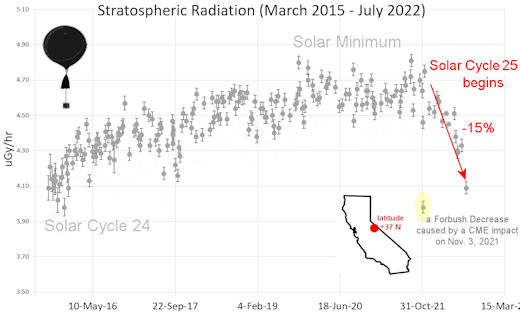
What's going on? Ironically, the radiation drop is caused by increasing solar activity. Solar Cycle 25 has roared to life faster than forecasters expected. The sun's strengthening and increasingly tangled magnetic field repels cosmic rays from deep space. In addition, solar coronal mass ejections (CMEs) sweep aside cosmic rays, causing sharp reductions called "Forbush Decreases." The two effects blend together to bring daily radiation levels down.
.Who cares? Cosmic rays are a surprisingly "down to Earth" form of space weather. They can alter the chemistry of the atmosphere, trigger lightning, and penetrate commercial airplanes. According to a study from the Harvard T.H. Chan school of public health, crews of aircraft have higher rates of cancer than the general population. The researchers listed cosmic rays, irregular sleep habits, and chemical contaminants as leading risk factors. A number of controversial studies (#1, #2, #3, #4) go even further, linking cosmic rays with cardiac arrhythmias and sudden cardiac death.
Technical notes: The radiation sensors onboard our helium balloons detect X-rays and gamma-rays in the energy range 10 keV to 20 MeV. These energies span the range of medical X-ray machines and airport security scanners.
Data points in the graph labeled "Stratospheric Radiation" correspond to the peak of the Regener-Pfotzer maximum, which lies about 67,000 feet above central California. When cosmic rays crash into Earth's atmosphere, they produce a spray of secondary particles that is most intense at the entrance to the stratosphere. Physicists Eric Regener and Georg Pfotzer discovered the maximum using balloons in the 1930s and it is what we are measuring today.
| | The official U.S. government space weather bureau |
| | The first place to look for information about sundogs, pillars, rainbows and related phenomena. |
| | Researchers call it a "Hubble for the sun." SDO is the most advanced solar observatory ever. |
| | 3D views of the sun from NASA's Solar and Terrestrial Relations Observatory |
| | Realtime and archival images of the Sun from SOHO. |
| | information about sunspots based on the latest NOAA/USAF Active Region Summary |
| | current counts of failed and deployed Starlink satellites from Jonathan's Space Page |
| | Authoritative predictions of space junk and satellite re-entries |
| | from the NOAA Space Environment Center |
| | fun to read, but should be taken with a grain of salt! Forecasts looking ahead more than a few days are often wrong. |
| | from the NOAA Space Environment Center |
| | the underlying science of space weather |
 | Getting YouTube comments is essential if you want to beat the algorithm! That’s why you need to buy YouTube comments from RealSocialz.com because they offer real USA comments you can customize. |
 | BestCSGOGambling is the best site for everything related to CSGO gambling on the web |
| | These links help Spaceweather.com stay online. Thank you to our supporters! |
| | | | | | |

